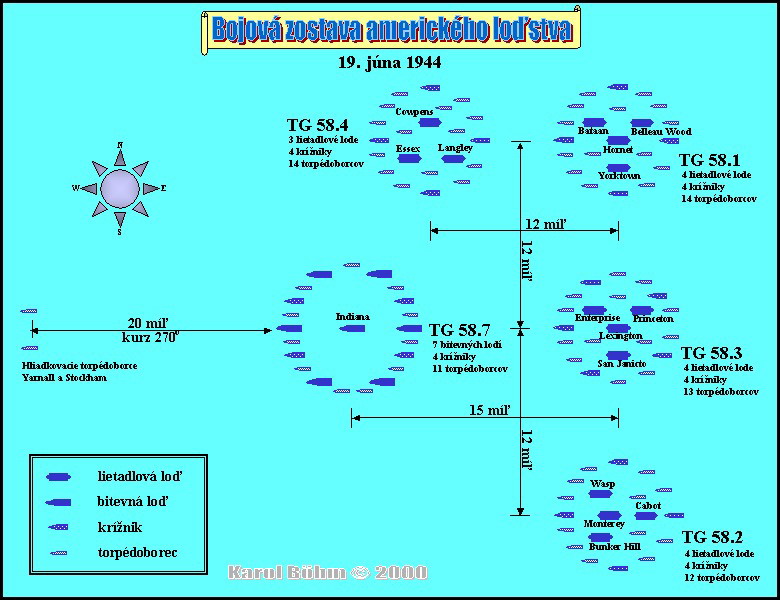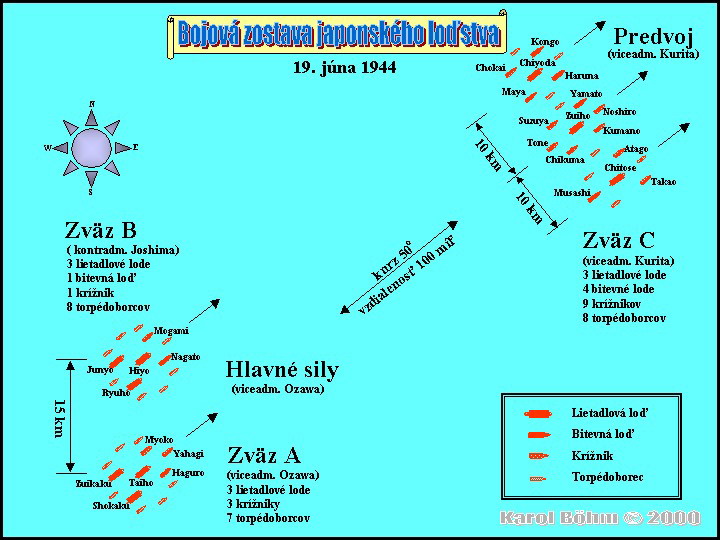The decisive encounter, in which will be one in stroke destroyed the U.S. Pacific Fleet, as requested by the principles of "New Operational Policy" from September 1943, the Imperial Navy has been preparing for several months. In this context, there has been done a major reorganization in the Combined Fleet, based on the principle that the U.S. Navy applied since the beginning of the war: the most important component of the fleets consists of aircraft carriers form unions while the capital ships with any powerful guns are used primarily for their defense ... ... The Japanese finally reached the stage where the commander of aircraft carriers had under his tactical command battleships and heavy cruisers and could use them operationally in its sole discretion. (Miloš Hubáček - Ofenziva v Pacifiku, Mladá fronta, 2000)
Article on Czech Wikipedia
Article on English Wikipedia| Scenario in dates: |
| June 10, 1944: |
In the Dutch East Indies - In a diversionary action, British aircraft from HMS Illustrious and HMS Atheling raid Japanese positions on Sabang. The intent is to distract Japanese attention from American forces approaching the Mariana Islands. |
| June 12, 1944: |
In the Mariana Islands - US naval forces continue attacks on Japanese positions in the island group. They concentrate on Tinian, Saipan and Guam. The Japanese fleets located at Tawitawi and Batjan set sail to counterattack. Admiral Kurita commands a vanguard force while Admiral Ozawa leads the main force. The main force from Tawitawi is sighted and reported by an American submarine. The Japanese have 5 fleet carriers, 2 light carriers, 2 seaplane carriers, 5 battleships as well as several cruisers and destroyers in support. The commander of the Combined Fleet, Admiral Toyoda, realizes that the American forces are numerically superior but he also expects support from the land-based aircraft on the islands. These air assets, however, are being depleted by American attacks. |
| June 15, 1944: |
In the Philippine Sea - Admiral Clark leads two groups of US carrier forces raiding Iwo Jima, Chichi Jima and Haha Jima. The Japanese ships are sighted by US submarine patrols. USS Flying Fish (SS-229) sights a Japanese carrier and battleship force coming out of San Bernardino Strait while a battleship and cruiser force steaming up from the south are seen east of Mindanao by USS Seahorse (SS-304). |
| June 16, 1944: |
In the Philippine Sea - Admiral Clark leads two groups of US carrier forces raiding Iwo Jima, Chichi Jima and Haha Jima. The Japanese fleets link up and refuel. US patrols make two sightings. To the north, off the island of Hachijo Jima, the Japanese transport ship Toyokawa Maru rammes and sinks the Japanese submarine I-6, which is after a sudden surfacing near a Japanese convoy mistakenly considered to be American. |
| June 17, 1944: |
In the Philippine Sea - The carriers led by Admiral Clark and the rest of the main US carrier forces sail for a rendezvous to the west of the Mariana Islands. Off the island of Saipan, the escort aircraft carrier USS Fanshaw Bay (CVE-70) is attacked from all sides by 70 Japanese aircraft. Several attackers are shot down, but one bomb penetrating the elevator shaft and an explosion below deck killing 14 and wounding 23. the Damage is brought under control by the crew and vessel can be repaired in Pearl Harbor. |
| June 18, 1944: |
In the Philippine Sea - The main US carrier forces rendezvous west of the Mariana Islands. Japanese scout planes sight the American fleet late in the day. The Japanese command intends to launch air strikes next morning, while still beyond range, and fly the aircraft to Guam to refuel and rearm. |
| June 19, 1944: |
In the Philippine Sea - In the early morning hours Japanese reconnaissance finds US Task Force 58 while remaining undetected. The Japanese immediately launch 372 aircraft, in four waves, to strike the American fleet. Overall, the Japanese have about 550 planes (including those on Guam) while the Americans have roughly 950. Furthermore, US radar provides significant advance warning of the attack. There is enough time to launch an air raid on Guam before the Japanese can arrive over their target. American fighters begin intercepting the incoming Japanese planes while 50 miles away. Many of the attackers are shot down before reaching the American fleet and US anti-aircraft defenses accounts for many more. The only hit achieved by the Japanese is on the USS South Dakota (BB-57) which is damaged by one bomb. The Japanese lose 240 aircraft and the Americans lose 29. The attackers fly on to Guam where American aircraft strike and destroy another 50 Japanese planes. Meanwhile, the Japanese aircraft carriers Taiho and Shokaku are sunk by the US submarines USS Cavalla (SS-244) and USS Albacore (SS-218). American participants refer to the day as "The Great Marianas Turkey Shoot" because of the ease with which the Japanese forces have been suppressed. |
| June 20, 1944: |
In the Philippine Sea - The Japanese fleet withdraws to refuel, believing that their aircraft have landed safely on Guam. US Task Force 58 (Admiral Mitscher) launches an air strike on the Japanese fleet in the late afternoon. The 216 American aircraft encounter 35 defending fighters and sink the carrier Hiyo. Two other Japanese aircraft carriers are damaged as are a battleship and a cruiser. US loses amount to 20 planes shot down and 72 crashing while attempting to land on their carriers in the dark. During the night, the Japanese fleet withdraws and are not pursued. |
| December 21, 1944: |
United States - US Navy documentary The Fighting Lady premieres in American cinemas. The film brings to life the true story of the aircraft carrier Yorktown (CV-10) during its operation duty in the Pacific, from close-ups of daily life on the carrier to authentic air combat footage from the Marcus and Truk raids and battle of the Philippine Sea. The work will win one of the first Oscars for a documentary. |
|
| Literature sources: |  | Jordan, David, Wiest Andrew: Atlas Of World War II., Ottovo nakladatelství, 2006, Praha |  | Saunders, Hrowe H.: Duell im Pazifik - Von Pearl-Harbor bis Hiroshima (Duel in Pacific - From Pearl Harbor to Hiroshima), Mustang, 1995, Plzeň |  | Pavlík, Jan: Japonské letadlové lodě z období II. sv. války, Svět křídel, 2003, Cheb |  | Stille, Mark: US navy aircraft carriers 1942-45, Grada Publishing, 2008, Praha |  . . | Bishop, Chris: Aircraft carriers, D-Consult, 2006, Praha |  | Hrbek, Jaroslav, Hrbek Ivan: Loďstva států účastnících se 2. sv. války (Fleets of states participating WW2), Naše vojsko, 1994, Praha |  | Piekalkiewicz, Janusz: Seekrieg 1939-1945, Mustang, 1997, Plzeň |  | Henry, Mark: US Navy in World War II, Grada, 2008, Praha |  | Bruce, George: Die Seeschlachten des XX. Jahrhunderts (Sea Battles of the 20th Century), Area, 2007, Praha |  . . | Sims, Edward H.: Největší vzdušné bitvy (The Largest Air Battles), Toužimský & Moravec, 2002, Praha |  | Hubáček, Miloš: Ofenzíva v Pacifiku (Offensive in Pacific), Mladá fronta, 2000, Praha |  | Hoyt, Edwin P.: The Carrier War, Beta - Dobrovský a Ševčík, 1999, Praha, Plzeň |  | Kolektiv, : War in the Pacific, Naše vojsko, 2006, Praha |  . . | Van Der Vat, Dan: The Pacific campaign : the U.S. Japanese naval war 1941-1945, Argo, 2000, Praha |  | Hrbek, Jaroslav, Hrbek Ivan: Vítězství přichází z moře (Victory comes from sea), Naše vojsko, 1999, Praha |
|




